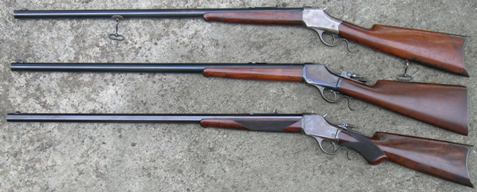June 26, 2013
 Offline
OfflineMy guess is it’s not, but wanted to run it by the experts here.
https://www.gunbroker.com/item/889489244
Don
April 15, 2005
 Offline
OfflineDon,
It is most likely original, but the butt stock checkering has been inexpertly “refreshed”. It is a bit odd to see H-pattern checkering on relatively plain grained stocks (though there is a small amount of figure in the butt stock). The checkering on the forend looks original and untouched.
Bert
WACA Historian & Board of Director Member #6571L

November 19, 2006
 Online
OnlineMy initial impression was the checkering is not original, but that could be from what Bert observed – an, “inexpert” job of freshening. Also, 1908 production does not imply to me, “incredibly early.” The bluing left a suspect taste for me. It is, after all, a gunbroker auction. I’m not saying all gunbroker rifles are flawed, but unless it is a respected known seller who I am familiar with, I am wary.
Let me add, the wear on the buttstock doesn’t match the lack of wear on the receiver. And, there was likely a reason the checkering needed to be freshened.
November 1, 2013
 Offline
OfflineOld-Win said
On this particular checkering pattern, Winchester used a ratio of about 3-1 or more.
How many rows or lines per inch, if you know? You’d sure think anyone copying the H pattern would stick to whatever this measurement was–it’s as simple a pattern as there is. Is this gun beyond the “letterable” range?
Found in another source: standard was 20 lines per inch, more for fancier patterns.
April 15, 2005
 Offline
OfflineI did not understand the “ratio” comment either. It is beyond the letterable range. The LPI used changed (became coarser) through the production period. That stated, the subject rifle is early enough that it should be 18-LPI.
WACA Historian & Board of Director Member #6571L

July 8, 2012
 Offline
OfflineFor comparison, Here are a couple of model 1894 straight grip deluxes that Leroy Merz has for sale:
https://www.merzantiques.com/product/w2823-winchester-1894-deluxe-special-order-rifle/
November 1, 2013
 Offline
Offlinetionesta1 said
For comparison, Here are a couple of model 1894 straight grip deluxes that Leroy Merz has for sale:https://www.merzantiques.com/product/w2823-winchester-1894-deluxe-special-order-rifle/
Forget the checkering–how can Merz say, without factory documentation, that this was ordered with the scope?
November 19, 2006
 Online
Onlineclarence said
tionesta1 said
For comparison, Here are a couple of model 1894 straight grip deluxes that Leroy Merz has for sale:
https://www.merzantiques.com/product/w2823-winchester-1894-deluxe-special-order-rifle/
Forget the checkering–how can Merz say, without factory documentation, that this was ordered with the scope?
I suppose he is basing it all on where the barrel markings are located?
April 15, 2005
 Offline
Offlinesteve004 said
I suppose he is basing it all on where the barrel markings are located?
Actually, he is basing in on the fact that the Proof mark on the barrel is stamped forward of the scope mount base. Ordinarily it would have been stamped much closer to the frame ring (and would be under the base). I see nothing wrong with his assertion that it was factory ordered with the scope.
WACA Historian & Board of Director Member #6571L

November 11, 2012
 Offline
OfflineBert H. said
I did not understand the “ratio” comment either. It is beyond the letterable range. The LPI used changed (became coarser) through the production period. That stated, the subject rifle is early enough that it should be 18-LPI.
I am sorry that I wasn’t more clear on the ratio. What I am referring to is the length of the diamond to its width. The length of the diamond is about 3 times as long is it is wide. The stock on the OP’s rifle has diamonds that are about 2-1. Early Winchesters that had checkering were done in a size of about 20 lines to the inch and by post WWII, had changed to about 17 or 18 lines per inch.
April 15, 2005
 Offline
OfflineOld-Win said
I am sorry that I wasn’t more clear on the ratio. What I am referring to is the length of the diamond to its width. The length of the diamond is about 3 times as long is it is wide. The stock on the OP’s rifle has diamonds that are about 2-1. Early Winchesters that had checkering were done in a size of about 20 lines to the inch and by post WWII, had changed to about 17 or 18 lines per inch.
Pre-1900 Fancy checkered stocks were frequently 20-LPI, post-1900 were 18-LPI, and the post WW II were 16-LPI.
WACA Historian & Board of Director Member #6571L

September 19, 2014
 Offline
OfflineOld Win, you are dead on about the diamond ratios. I would about bet you have done some checkering in the past? I know I have a checkered past! The comparison of the buttstock and forend shows the differences in the layout of the patterns and the fineness of the diamonds. Tim
November 19, 2006
 Online
OnlineBert H. said
Actually, he is basing in on the fact that the Proof mark on the barrel is stamped forward of the scope mount base. Ordinarily it would have been stamped much closer to the frame ring (and would be under the base). I see nothing wrong with his assertion that it was factory ordered with the scope.
Bert – yes – that is what I meant – the placement location of the proof mark on the barrel. I can’t think of another explanation why they would have placed it there.
1 Guest(s)


 Log In
Log In






